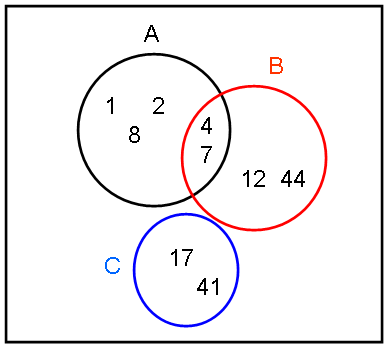Review
GRE Data Analysis - Counting, Sets
A set is a collection of distinct objects, that have a specific property. For example, the set of all digits greater than 5 includes the numbers 6, 7, 8, and 9. Data analysis questions on the GRE revised exam may be straight-forward that merely require you to know a few definitions about sets and set notation, or may require to you perform an operation on a collection of sets.
The objects in a set are called the members, or elements, of that set. A set can be finite, which means that its members can be counted, or a set can be infinite. An example of a finite set is the set of all even digits (which are 0, 2, 4, 6, and 8), and an example of an infinite set is the set of all negative integers. The members of a finite set are depicted using curly brackets. For example, the set of all digits less than 9 and greater than 2 is denoted as: {3, 4, 5, 6, 7, 8}. If a set contains more than one of an element, that element is not listed twice when the set is given. A set is named using a variable. For example, the following notation states that the set S contains all of the digits less than 9 and greater than 2:
S = {3,4,5,6,7,8}
A set that contains no members is called the empty set, and is denoted with the symbol ∅. If all of the members of set X are also members of set Y, then we say that X is a subset of Y. For example, if X={2,3,7,8} and Y={1,2,3,5,7,8,32}, then X is a subset of Y.
Performing Operations on Sets
Question on the GRE exam may require you to perform operations on sets. Two operations that you should be familiar with are intersection and union. The intersection of two or more sets is the set of all members that appear in all of the sets, while the union of several sets is are those elements that are in any of the designated sets. For example, assume that you have the following three sets:
A={1,2,4,7,8}
B={4,7,12,44}
C={17,41}
The intersection of sets A and B, which is denoted as A∩B, the union of sets A and C, denoted as A∪B, and the intersection of sets B and C are the following:
A∩B = {4,7}
A∪C = {1,2,4,7,8,17,41}
B∩C = ∅
If two sets have no members in common, then the two sets are called disjoint. For example, sets A and C from above are disjoint. A set that has no members, also called the empty set, is denoted by ∅, while a set that has members is called nonempty. A Venn Diagram is one way that sets can be visualized. In a Venn diagram, each set is represented as a circle, and all of the members of that set are written inside that circle. Using a Venn diagram, it is easy to see if two or more sets have intersecting elements, or if any of the sets are disjoint. The Venn diagram for the sets A, B and C is the following:

The Inclusion-Exclusion Principle
A counting principle that you may appear on a data analysis question on the GRE revised exam is the inclusion-exclusion principle, which states that the number of elements in the union of two finite sets equals the count of the members in the two sets minus the number of elements in the intersection of the two sets. The number of elements in a set is denoted using two parallel lines, ||. Using set notation, the inclusion-exclusion principle for sets D and E is written as the following:
|D∪E| = |D| + |E| - |D∩E|